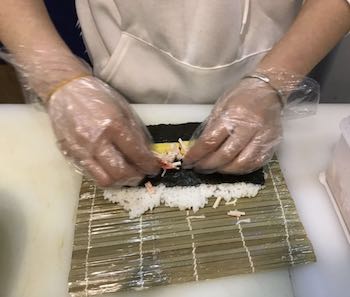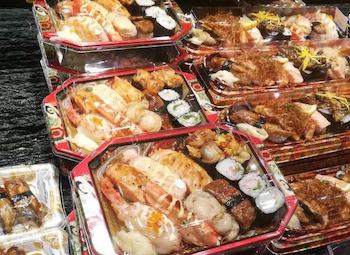We are reader supported. When you purchase through links on our site, we may earn an affiliate commission. Also, as an Amazon affiliate, we earn from qualifying purchases.

I grabbed a spicy tuna roll from the grocery store on my way home from the office but forgot all about it until next morning. Now, I had a big question staring at me – should I eat that roll or toss it away? I decided to not risk my health and do quick research to find the right answer.
How Long Is Grocery Store Sushi Good For? If the sushi contains raw fish, it can last for 24 hours when refrigerated and if it has cooked fish or vegetables, it can stay good for more than 3 days. As a rule, you must not eat sushi if it is left outside for more than 2 hours at room temperature.
Even if you store sushi in ideal conditions, this Japanese delicacy has the tendency to lose its quality and the texture will not be the same after 24 hours or 3 days. Read on to find out interesting facts about store-bought sushi and how to tell whether a grocery store sushi is good for consumption or not.
Why Is There A Safe Period For Grocery Store Sushi?
Ideally, sushi is meant to be eaten within 30 to 60 seconds of the chef placing it in front of you at room temperature. However, the biggest problem with grocery store sushi is that there is no in-house chef making it. The sushi is probably prepared at an outside facility that sends them to outlets for sale.
Even though it has an expiry or use-by date on the package, you can’t really tell how long it had been sitting on the shelf before you bought it. The safety window for store-bought sushi depends on three important factors:
- What food safety practices are followed by the retailer
- How long the sushi was displayed on the shelf
- What you do next after purchasing it
What Are The Food Safety Practices
If the sushi contains raw fish, the retailer must ensure that it is sashimi-grade fish that has been frozen in ideal temperature to prevent the growth of bacteria. The ready-made sushi should also be kept in the refrigerator because displaying them on a shelf can give a favorable breeding ground to bacteria.
Interestingly, it’s not just the raw fish that you must be concerned about because the rice also goes bad after a certain safe period. If sushi rice is left at room temperature for over 7 hours, a bacteria named Bacillus cereus can grow on it.
That’s the reason why sushi rice is seasoned with vinegar immediately after it is cooled. Bacteria can’t grow on it if the rice has been acidified to 4.2 pH but with sushi made at an outside facility, you cannot guarantee that.
How Long The Sushi Was Displayed On The Shelf
At the grocery stores, it is a common practice to display sushi at room temperature on the shelves as this helps in maintaining the texture, quality, and taste. However, let’s not forget that no matter how attractive sushi looks on the shelves, room temperature is ideal for harmful bacteria to grow.
Some stores may display sushi in chilled units and maintain a temperature of 2 to 4 degrees for sushi containing raw fish. This increases the ‘safe period’ of grocery store sushi and helps in preventing further bacterial growth.
What You Do Next After Purchasing It?
Ideally, I would suggest that you eat the store sushi immediately after buying to eliminate any health risk after the food is off the shelf. If you plan to eat it later, there are a few things that you will need to consider and I have mentioned them below.
- Buy sushi early in the morning as this is probably the time when they come in fresh and store them in a refrigerator at work or home.
- Purchase from a store where they prepare sushi right in front of you. Some grocery stores may have a section that makes fresh sushi that stays good up to 24 if refrigerated.
- When buying ready-made sushi, always choose a store that displays them in a chilling unit to maintain the temperature and prevent bacterial contamination. Check the expiry or use-by date if it has one.
- Make sure you always buy from a popular grocery store that has a high turnover for sushi, because this will guarantee that the sushi goes off the shelves at a faster pace and the cases are refilled constantly.
- When you are in doubt, don’t hesitate to ask the retailer how the sushi was prepared, how long it had been sitting on the store shelf or what measures do they take to ensure the sushi is safe to eat.
Related Article: How Often Can You Eat Sushi?
How To Tell If The Sushi Has Gone Bad
No matter how much you love sushi, if it has started deteriorating or gone bad already, it is best tossed out of the window. Even the slightest bacterial contamination may cause health risks for you, so here are a few ways to tell if the sushi has gone bad:
Use your eyes:
You must use your eyes to tell whether or not the sushi is fresh by simply looking at the color and texture. If the sushi rice looks hard and dry, it’s probably beyond the freshness window. Similarly look at the raw fish slices closely. Does it look discolored or dull? Sushi grade fish will have a natural shine and look attractive.
Touch and feel:
If possible, touch the fish to check whether it is fresh or has a slimy feel to it. If the outer layer has a slimy covering on it, you should avoid buying that sushi. If you are concerned about the health risks associated with store-bought sushi, I would suggest that you avoid spicy tuna rolls or other varieties that are made of chopped-up fish bits.
Is it chilled?
If the sushi contains raw fish, it must be refrigerated to maintain the quality. According to FDA, packaged store sushi must be refrigerated so don’t buy if it is not kept in a chilling unit. Although sushi containing vegetables have a longer freshness window than fish, they are also prone to losing texture if kept at room temperature for more than 24 hours.
Check expiry date:
Check the package to see if the expiry date or use-by date is printed on it. If the date has passed, you must not consume it. As a rule of thumb, raw fish refrigerated in proper conditions is safe to consume for three days. Sushi made from cooked vegetables or fish can be stored for up to a week at below 41º F and about five days at 45º F.
Related Article: Can You Eat Sushi For Breakfast?
What Is The Difference Between Grocery Bought And Homemade Sushi
In the grocery store-bought sushi, the rice is either too mushy or too dry. If you taste them fresh, they will mostly have a baby food kind of texture and if left outside for long, it may get too dry unlike homemade sushi rice that is soft and the grains separate easily.
The flavor of rice in grocery sushi is usually off because the chef adds an excess amount of vinegar and sugar to prevent them from spoiling. Thus, the rice overpowers the taste of fish. In homemade sushi, rice is seasoned in the right proportion to strike a perfect balance between rice and fish or vegetables.
Raw fish tastes best when the chef’s hands warm it while preparing. You can’t experience that warmth of personal touch in store-bought sushi that is chilled at low temperatures. Furthermore, the quality of fish is usually not that high as you find in a high-end sushi bar, even though the fish is sushi-grade.

When you make homemade sushi, you can take advantage of the season and buy fish that tastes best at that time of the year. In a grocery store, you do not have many options and it’s always spicy tuna roll on the shelves.
The freezing technology used for sushi-grade fish highly influences the flavor. For homemade sushi, you can shop and choose from the best fishmongers who use the latest technology that keeps the flesh perfect intact at minus 65 degrees. Cheap freezing methods may cause crystallization that degrades the overall flavor.
If you also want to know what is the difference between Grocery Store Sushi vs Restaurant Sushi you can have a look at my previous article here.
Related Questions
Can you microwave grocery store bought sushi?
Yes, you can microwave but this will cook the raw fish and alter its flavor. To prevent this, a sushi expert provides a small hack – heat chilled sushi for 30 seconds at 500 watts to bring it to room temperature and prevent the onset of the cooking process.
Is it okay to eat store-bought sushi if it looks good beyond use-by date?
No, I would strongly suggest that you toss away the sushi if it has passed the expiry or use-by date. The bacteria are too small to be seen by the naked eye, so what looks good to you may actually be contaminated with parasites. When in doubt, just throw it away because nothing in this world is more precious than your health!


Comments
Pingback: Does Sushi Count As Fast Food? - Easy Homemade Sushi
Pingback: Why Are Sushi Restaurants Closed on Mondays? - Easy Homemade Sushi